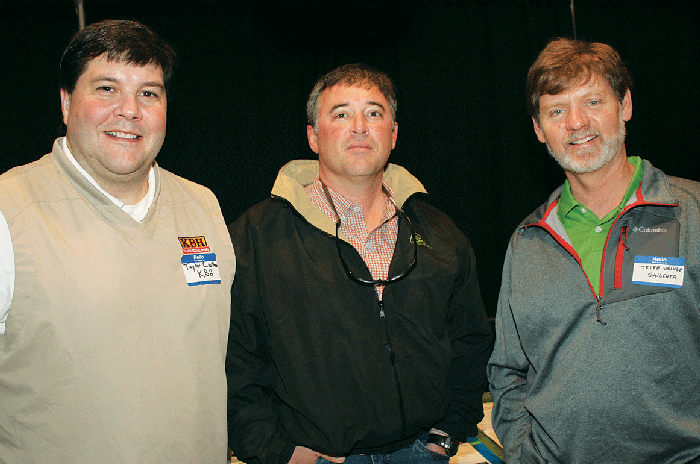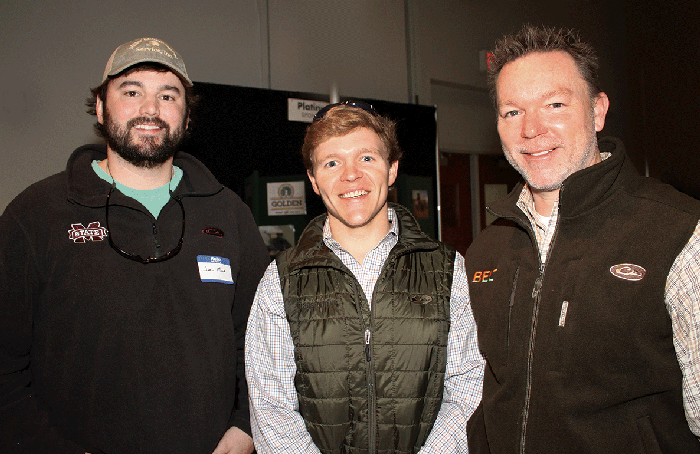
Mississippi peanut growers can improve their chances for success, says Dr. Jason Sarver — and save some money in the process — by planting when soil temperatures are most favorable for germination, paying attention to seeding rate, and using an inoculant.
“Probably the most calls I get each spring are, ‘My seed aren’t coming up; did I get bad seed?’ he said at the annual meeting of the Mississippi Peanut Growers Association at Mississippi State University.
Sarver, who is the state’s Extension peanut specialist, pointed to hours-after-planting studies in Georgia, where he was located before coming to Mississippi, that were done on germination tables where temperatures could be precisely controlled.
“At a soil temperature of 65 degrees, which has been our historical recommendation for planting runner peanuts, three days after planting we had only about 10 percent germination. But at 70 degrees — just a 5 degree increase in temperature — germination had increased to 50 percent, and at 74 degrees is was averaging almost 70 percent.
Taylor Cauthen, from left, KBH Corp., Clarksdale, Miss.; Heath Hill, Triangle Chemical, Greenwood, Miss.; and Tripp Walker, Syngenta, Starkville, Miss., were among commercial representatives at the annual convention of the Mississippi Peanut Growers Association.
“A week after planting, at 65 degrees soil temperature, we had 70 percent germination, but not that much emergence — there were a lot of seedlings still in the ground. At 70 degrees to 74 degrees, we were at about 90 percent to 95 percent germination, which is about where we want to be a week after planting.”
The last few years in Mississippi, Sarver says, “We had a lot of seed going in the ground at 50, 55, 60 degrees. Sometimes 60 degrees can be OK, if you know it’s going to be 85 degrees for the next few days. But how often does that happen? Peanuts are a tropical crop, typically bred in the Deep South or West Texas, places with more heat units over a longer period than we get here. We need to have optimum soil temperatures to get the best germination and emergence. We’ve got to get our crop up and growing in order to get the best growth and yields.”
In 2014 and 2015, in the north half of the state, he says, “we didn’t get 70 degree soil temperatures until about the first week of May. In 2016, it was about the 25th of April.
DON’T WASTE SEED
Seeding rates are another perennial grower question, Sarver says. “They ask why we’re lagging behind some Georgia growers who use higher seeding rates, some as high as 150 pounds to 160 pounds per acre. In Mississippi, I think that’s excessive.
“For GA 06G, I want about 6 seed per row foot in single rows, about 120 pounds per acre. If you’re planting 150 pounds — my own opinion, based on everything I’ve seen here — you’re wasting 30 pounds of seed. With the lower rate, you can instantly save $22 to $30 per acre in seed costs.
“Peanuts are about as elastic a plant as you could want in terms of being able to compensate for poor stands. In my Georgia work, we maximized yield potential at 3 plants per foot. At 150 pounds, that’s 8 seed to 9 seed per row foot. It would take some really bad conditions to plant that many seed and end up with only 3 per row foot. I think 6 seed per row foot is our magic number in Mississippi.”
Joel Moor, from left, Mississippi State University entomology graduate student, Indianola, Miss.; chats with Morgan McDowell, PhytoGen Cottonseed; and David Cummins, Bayer Crop Science, both at Madison, Miss. They were among those attending the annual meeting of the Mississippi Peanut Growers Association.
For twin rows, Sarver says, “Our recommendation is about 6-1/2 seeds per row foot, divided between the two rows, giving you about 3-1/4 seed per row foot. I really feel confident with our recommendation. Even in twin rows, I think 150 pounds to 160 pounds is going to be excessive.”
With twin rows, too, he says, “We’ve seen a consistent trend across the years of planting date effect on yields.” Planting twin rows in optimum soil temperatures resulted in an average 6.8 percent yield increase. But, he says, late planting can cost yield for both twin rows and single rows.
“Applying a yield loss equation, with twin rows we lost about 60.4 pounds per acre of yield potential per day by planting after May 7, and about 48 pounds for single rows. If you’ve got a 5,000 pound yield potential, our equation shows that with twin rows you’re down to 4,300 pounds planting mid-May, and that drops to about 3,600 pounds for June 1 planting. With single rows, the 5,000 pound potential drops to about 4,700 pounds when planting May 7; 4,100 pounds when planting May 19; and 3,525 pounds when planting June 1.”
In 2014 trials, Sarver says, there was about a 7 percent yield advantage for peanuts planted in twin rows, and about a 5 percent advantage in 2015. But, he notes, “I think if you’re in a typical wide row, 38 inch to 40 inch single row system, you will make more peanuts by switching to twin rows — but you have to consider the economic factors involved.”
INOCULANT ‘A NO-BRAINER’
As for whether or not to use an inoculant, “All the studies show it’s a real no-brainer,” he says. “In new peanut fields particularly, it’s the best $8 to $10 you’re going to spend all year. And that’s true even in fields with a recent history of peanuts. Some growers in other states will say you don’t need to inoculate in fields that have been in peanuts for three or four years, but as many failures as I’ve seen in Mississippi, I’m going to use inoculant every time. In 35 trials in North Carolina, where conditions are similar to Mississippi, there has been about 200 pounds per acre advantage using an inoculant. An extra 200 pounds of peanuts will pay for your inoculant every time — it’s good, cheap insurance.”
To drive home the point that inoculant is “the most important thing you’re going to put in the tank on new ground,” Sarver says with nitrogen rates as high as 180 pounds per acre on non-inoculated peanuts, “they still never caught up to those that were inoculated.
You’re spending well north of $100 on nitrogen, and you’re still not catching up to the yield that $8 to $10 worth of inoculant will give for peanuts with 90 pounds of N.”
In 2016, Sarver says, the USDA showed Mississippi with 39,000 planted acres and harvested acres in the low 38,000 acre range. Yield average was 4,100 pounds. “Mississippi was second to Arkansas, which had the highest U.S. yield, 4,800 pounds per acre, which was far and away the highest average yield in a state ever — a very impressive achievement.
“But with the year we had, with severe drought in east Mississippi and other weather setbacks, I’m pretty happy with our 4,100 pound state average.”
Acreage “has shifted around in the last five or six years,” Sarver says, “but it remains widely dispersed over the state. Holmes is the only county that had over 5,000 certified acres of peanuts in 2016.”
Mississippi had about 2.7 percent of the U.S. peanut production. That compares with 2.7 percent of the nation’s soybeans, 0.6 percent of the corn, 5.5 percent of the rice, and 5.2 percent of the cotton.
About the Author(s)
You May Also Like




